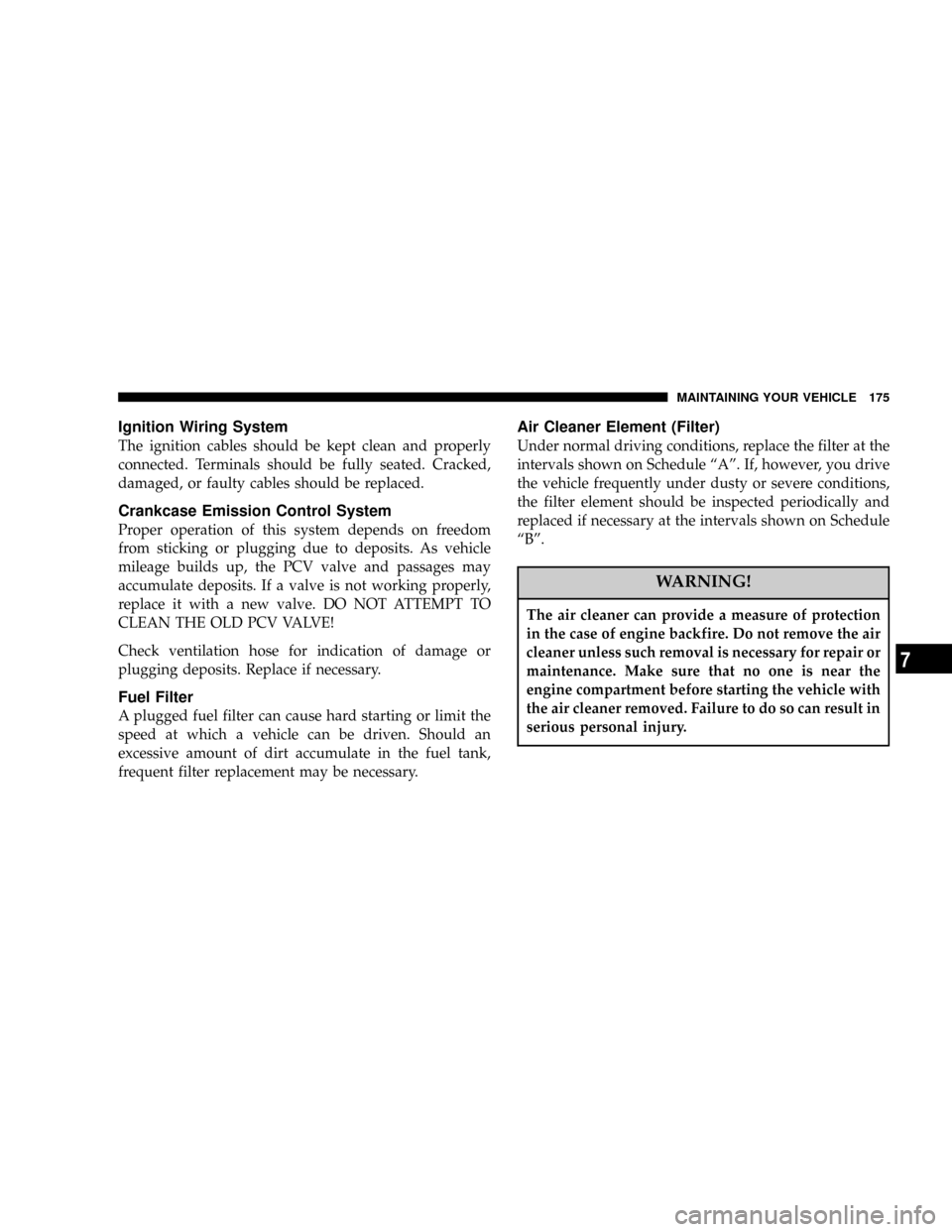2005 DODGE NEON wiring
[x] Cancel search: wiringPage 34 of 246

3.The driver and front passenger seats should be
moved back as far as practical to allow the front airbags
room to inflate.
4.If your vehicle has side airbags, do not lean against
the door, airbags will inflate forcefully into the space
between you and the door.
WARNING!
²Relying on the airbags alone could lead to more
severe injuries in a collision. The airbags work with
your seat belt to restrain you properly. In some
collisions the airbags won't deploy at all. Always
wear your seat belts even though you have airbags.
²Being too close to the steering wheel or instru-
ment panel during airbag deployment could cause
serious injury. Airbags need room to inflate. Sit
back, comfortably extending your arms to reach
the steering wheel or instrument panel.
²If the vehicle has side airbags, they also need
room to inflate. Do not lean against the door. Sit
upright in the center of the seat.
Airbag System Components
The front airbag system consists of the following:
²Airbag Control Module (ACM)
²AIRBAG Readiness Light
²Driver Airbag
²Passenger Airbag
²Steering Wheel and Column
²Instrument Panel
²Crash Sensor
²Interconnecting Wiring
²Knee Impact Bolsters
The side airbag system, if equipped, consists of the
following:
²AIRBAG Readiness Light (shared with the front airbag
system)
²Side Airbag in the Driver's Seat
²Side Airbag in the Passenger's Seat
34 THINGS TO KNOW BEFORE STARTING YOUR VEHICLE
Page 35 of 246

²Right and Left Side Impact Airbag Control Modules
(SIACM)
²Interconnecting Wiring
How The Airbag System Works
Front Airbag System
²The front Airbag Control Module determines if a
frontal collision is severe enough to require the airbags
to inflate.
²The Airbag Control Module is not designed to detect
side, roll over, or rear collisions.
²The Airbag Control Module also monitors the readi-
ness of the electronic parts of the system whenever the
ignition switch is in the START or ON/RUN positions.
These include all of the items listed above except the
knee bolsters, the instrument panel, and the steering
wheel and column. If the key is in the OFF position, in
the ACC position, or not in the ignition switch, the
airbags are not on and will not inflate.
²The Airbag Control Module also turns on the AIRBAG
light in the instrument panel for 6 to 8 seconds when
the ignition switch is first turned to ON/RUN, then
turns the light off. If it detects a malfunction in any
part of the system, it turns on the light either momen-
tarily or continuously.
Airbag Light
THINGS TO KNOW BEFORE STARTING YOUR VEHICLE 35
2
Page 38 of 246

²In moderate to severe side collisions, the side airbag
inflator on the crash side of the vehicle is triggered by
the appropriate SIACM, releasing a quantity of non-
toxic gas. The inflating side airbag exits through the
seat seam into the space between the occupant and the
door. The side airbag moves at a very high speed and
with such a high force, that it could injure you if you
are not seated properly, or if items are positioned in
the area where the side airbag inflates. This especially
applies to children.
Enhanced Accident Response Time Ð If Equipped
If the airbags deploy after an impact and the electrical
system remains functional, vehicles equipped with
power door locks will unlock automatically. In addition,
approximately 10 seconds after the vehicle has stopped
moving, the interior lights will light until the ignition
switch is turned off.
Maintaining Your Airbag Systems
WARNING!
²Modifications to any part of the airbag system
could cause it to fail when you need it. You could
be injured because the airbags are not there to
protect you. Do not modify the components or
wiring, including adding any kind of badges or
stickers to the steering wheel hub trim cover or
the upper right side of the instrument panel. Do
not modify the front bumper, vehicle body struc-
ture, or frame.
²You need proper knee impact protection in a
collision. Do not mount or locate any aftermarket
equipment on or behind the knee bolster.
²It is dangerous to try to repair any part of the
airbag system yourself. Be sure to tell anyone who
works on your vehicle that it has airbags.
38 THINGS TO KNOW BEFORE STARTING YOUR VEHICLE
Page 163 of 246

MAINTAINING YOUR VEHICLE
CONTENTS
m2.0L Engine Compartment...............165
mOnboard Diagnostic System Ð OBD II......166
mEmissions Inspection And Maintenance
Programs
............................167
mReplacement Parts.....................168
mDealer Service........................168
mMaintenance Procedures.................169
NEngine Oil..........................169
NIgnition Wiring System.................175
NCrankcase Emission Control System........175
NFuel Filter..........................175
NAir Cleaner Element (Filter)..............175NMaintenance-Free Battery................176
NAir Conditioner......................177
NPower Steering Fluid Check..............178
NFront Suspension Ball Joints..............178
NBody Lubrication.....................178
NWindshield Wiper Blades................179
NWindshield Wiper Blade Replacement.......179
NWindshield Washer Aiming..............180
NWindshield Washer Reservoir.............180
NExhaust System......................180
NCooling System.......................181
7
Page 175 of 246

Ignition Wiring System
The ignition cables should be kept clean and properly
connected. Terminals should be fully seated. Cracked,
damaged, or faulty cables should be replaced.
Crankcase Emission Control System
Proper operation of this system depends on freedom
from sticking or plugging due to deposits. As vehicle
mileage builds up, the PCV valve and passages may
accumulate deposits. If a valve is not working properly,
replace it with a new valve. DO NOT ATTEMPT TO
CLEAN THE OLD PCV VALVE!
Check ventilation hose for indication of damage or
plugging deposits. Replace if necessary.
Fuel Filter
A plugged fuel filter can cause hard starting or limit the
speed at which a vehicle can be driven. Should an
excessive amount of dirt accumulate in the fuel tank,
frequent filter replacement may be necessary.
Air Cleaner Element (Filter)
Under normal driving conditions, replace the filter at the
intervals shown on Schedule ªAº. If, however, you drive
the vehicle frequently under dusty or severe conditions,
the filter element should be inspected periodically and
replaced if necessary at the intervals shown on Schedule
ªBº.
WARNING!
The air cleaner can provide a measure of protection
in the case of engine backfire. Do not remove the air
cleaner unless such removal is necessary for repair or
maintenance. Make sure that no one is near the
engine compartment before starting the vehicle with
the air cleaner removed. Failure to do so can result in
serious personal injury.
MAINTAINING YOUR VEHICLE 175
7
Page 238 of 246

Fuel..............................141,203
Adding............................. 144
Capacity............................ 202
Filler Cap........................... 144
Filter.............................. 175
Gauge.............................. 79
Light............................... 79
Octane Rating........................ 141
Tank Capacity........................ 202
Fuel System Caution.................... 143
Fuses................................ 195
GasCap .............................. 144
Gasoline............................. 202
Gasoline, Reformulated.................. 142
Gasoline/Oxygenate Blends............... 142
Gauges
Coolant Temperature................... 81
Fuel................................ 79
Tachometer.......................... 78
Gearshift............................. 117
General Information...................... 13
Glass Cleaning......................... 194Hazard Warning Flasher.................. 150
Head Restraints......................... 57
Headlights............................. 61
Bulb Replacement..................... 199
Cleaning............................ 194
High Beam........................... 78
Switch.............................. 61
Heater............................... 101
Hood Prop............................ 59
Hood Release.......................... 58
Hoses............................... 185
Ignition
Key ................................. 9
Wiring System....................... 175
Immobilizer.......................... 11,22
Infant Restraint......................... 40
Inside Rearview Mirror................... 51
Instrument Cluster..................75,76,77
Instrument Panel and Controls.............. 74
Instrument Panel Cover.................. 194
Instrument Panel Lens Cleaning............ 195
Interior Appearance Care................. 193
238 INDEX
Page 245 of 246

Warning Lights (Instrument Cluster Description) . 77
Warnings and Cautions.................... 6
Warranty Information.................... 227
Washer, Adding Fluid................... 180
Washers, Windshield..................... 63
Washing Vehicle........................ 192
Wheel Alignment and Balance............. 139
Wheel and Wheel Trim Care............... 193
Wind Buffeting......................... 69
Window Fogging....................... 109
Windows
Power.............................. 23
Windshield Washer Aiming............... 180
Windshield Washers..................... 63
Fluid.............................. 180
Windshield Wiper Blades................. 179
Windshield Wipers...................... 63
Wiper Blade Replacement................. 179
Wipers, Intermittent...................... 64
Wiring, Ignition........................ 175
INDEX 245
10